miR-377 induces senescence in human skin fibroblasts by targeting DNA methyltransferase 1
- PMID: 28277545
- PMCID: PMC5386568
- DOI: 10.1038/cddis.2017.75
miR-377 induces senescence in human skin fibroblasts by targeting DNA methyltransferase 1
Erratum in
-
Correction: miR-377 induces senescence in human skin fibroblasts by targeting DNA methyltransferase 1.Cell Death Dis. 2019 Nov 12;10(11):859. doi: 10.1038/s41419-019-2097-9. Cell Death Dis. 2019. PMID: 31719519 Free PMC article.
Abstract
Skin aging is a complicated physiological process and epigenetic feature, including microRNA-mediated regulation and DNA methylation, have been shown to contribute to this process. DNA methylation is regulated by DNA methyltransferase, of which DNA methyltransferase 1 (DNMT1) is the most abundantly known. But evidence supporting its role in skin aging remains scarce, and no report regards its specifical upstream-regulating molecules in the process of skin aging so far. Here, we found that DNMT1 expression was markedly higher in young human skin fibroblasts (HSFs) than that in passage-aged HSFs, and DNMT1 knockdown significantly induced the senescence phenotype in young HSFs. We predicted the upstream miRNAs which could regulate DNMT1 with miRNA databases and found miR-377 had high homology with a sequence in the 3'-UTR of human DNMT1 mRNA. We confirmed that miR-377 was a potential regulator of DNMT1 by luciferase reporter assays. miR-377 expression in passage-aged HSFs was markedly higher than that in the young HSFs. miR-377 overexpression promoted senescence in young HSFs, and inhibition of miR-377 reduced senescence in passage-aged HSFs. Moreover, these functions were mediated by targeting DNMT1. Microfluidic PCR and next-generation bisulfite sequencing of 24 senescent-associated genes' promoters revealed alterations of the promoter methylation levels of FoxD3, p53, and UTF1 in HSFs treated with miR-377 mimics or inhibitors. We also verified that the miR-377-mediated changes in p53 expression could be reversed by regulation of DNMT1 in HSFs. Similarly, there was a negative correlation between miR-377 and DNMT1 expression in young and photoaged HSFs, HSFs, or skin tissues from UV-unexposed areas of different aged donors. Our results highlight a novel role for miR-377-DNMT1-p53 axis in HSF senescence. These findings shed new light on the mechanisms of skin aging and identify future opportunities for its therapeutic prevention.
Conflict of interest statement
The authors declare no conflict of interest.
Figures
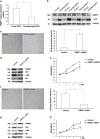
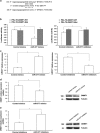
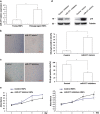
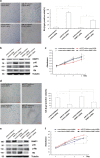

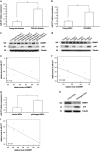
Similar articles
-
Microrna-217 modulates human skin fibroblast senescence by directly targeting DNA methyltransferase 1.Oncotarget. 2017 May 16;8(20):33475-33486. doi: 10.18632/oncotarget.16509. Oncotarget. 2017. PMID: 28380423 Free PMC article.
-
The Ubiquitin-like with PHD and Ring Finger Domains 1 (UHRF1)/DNA Methyltransferase 1 (DNMT1) Axis Is a Primary Regulator of Cell Senescence.J Biol Chem. 2017 Mar 3;292(9):3729-3739. doi: 10.1074/jbc.M116.750539. Epub 2017 Jan 18. J Biol Chem. 2017. PMID: 28100769 Free PMC article.
-
MicroRNA-21 and microRNA-148a contribute to DNA hypomethylation in lupus CD4+ T cells by directly and indirectly targeting DNA methyltransferase 1.J Immunol. 2010 Jun 15;184(12):6773-81. doi: 10.4049/jimmunol.0904060. Epub 2010 May 17. J Immunol. 2010. PMID: 20483747
-
Interplay between DNA Methyltransferase 1 and microRNAs During Tumorigenesis.Curr Drug Targets. 2021;22(10):1129-1148. doi: 10.2174/1389450122666210120141546. Curr Drug Targets. 2021. PMID: 33494674 Review.
-
A method to detect DNA methyltransferase I gene transcription in vitro in aging systems.Methods Mol Biol. 2007;371:73-80. doi: 10.1007/978-1-59745-361-5_6. Methods Mol Biol. 2007. PMID: 17634574 Free PMC article. Review.
Cited by
-
Epigenetic Regulation of Skin Cells in Natural Aging and Premature Aging Diseases.Cells. 2018 Dec 12;7(12):268. doi: 10.3390/cells7120268. Cells. 2018. PMID: 30545089 Free PMC article. Review.
-
Protective effects of galangin against H2O2/UVB-induced dermal fibroblast collagen degradation via hsa-microRNA-4535-mediated TGFβ/Smad signaling.Aging (Albany NY). 2021 Dec 10;13(23):25342-25364. doi: 10.18632/aging.203750. Epub 2021 Dec 10. Aging (Albany NY). 2021. PMID: 34890367 Free PMC article.
-
DNA methylation protects cancer cells against senescence.Nat Commun. 2025 Jul 1;16(1):5901. doi: 10.1038/s41467-025-61157-7. Nat Commun. 2025. PMID: 40595593 Free PMC article.
-
The Pathobiology of Skin Aging: New Insights into an Old Dilemma.Am J Pathol. 2020 Jul;190(7):1356-1369. doi: 10.1016/j.ajpath.2020.03.007. Epub 2020 Apr 1. Am J Pathol. 2020. PMID: 32246919 Free PMC article. Review.
-
Haplopelma hainanum venom induces inflammatory skin lesions.PeerJ. 2020 Jan 10;8:e8264. doi: 10.7717/peerj.8264. eCollection 2020. PeerJ. 2020. PMID: 31942253 Free PMC article.
References
Publication types
MeSH terms
Substances
LinkOut - more resources
Full Text Sources
Other Literature Sources
Medical
Research Materials
Miscellaneous

